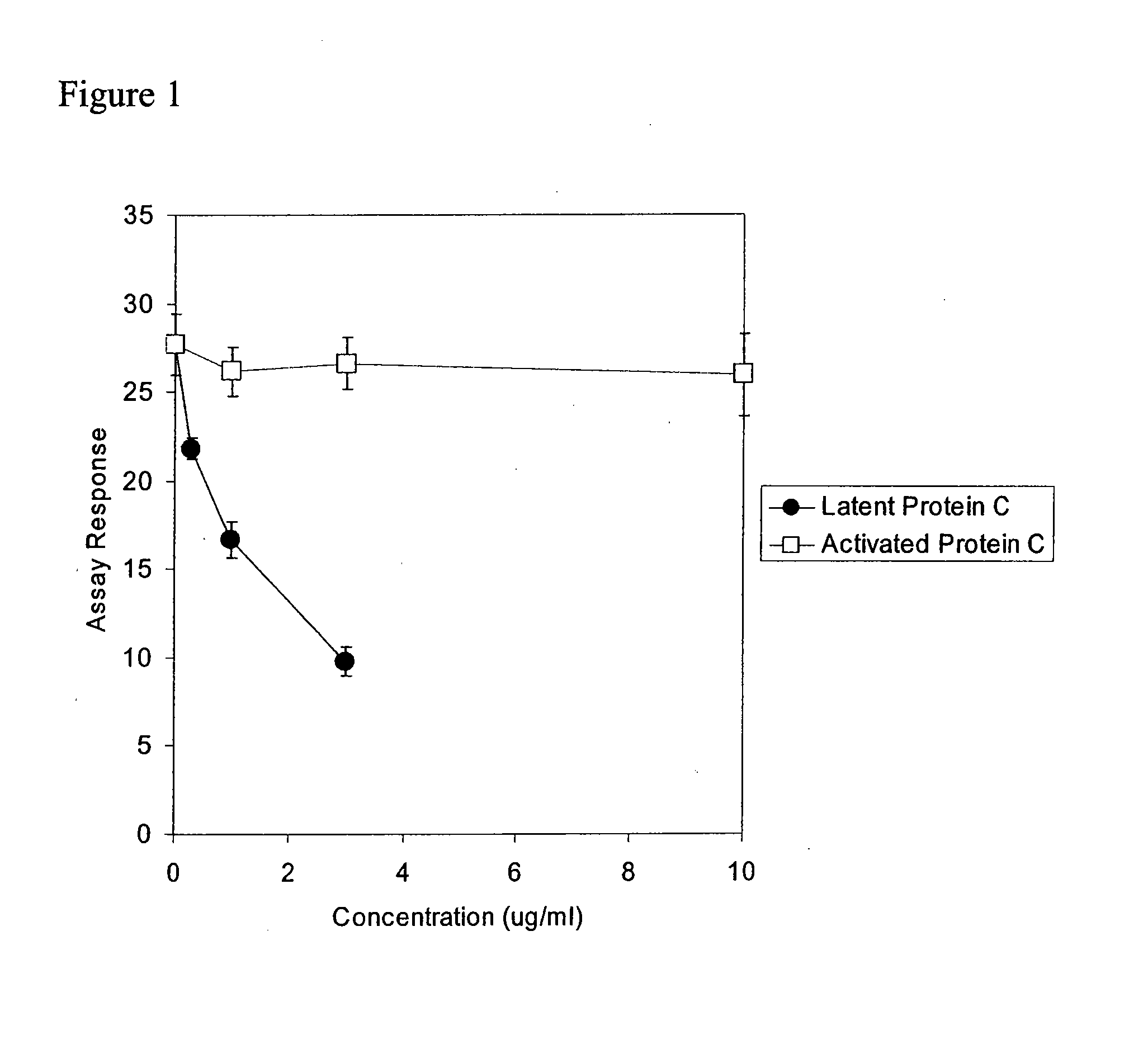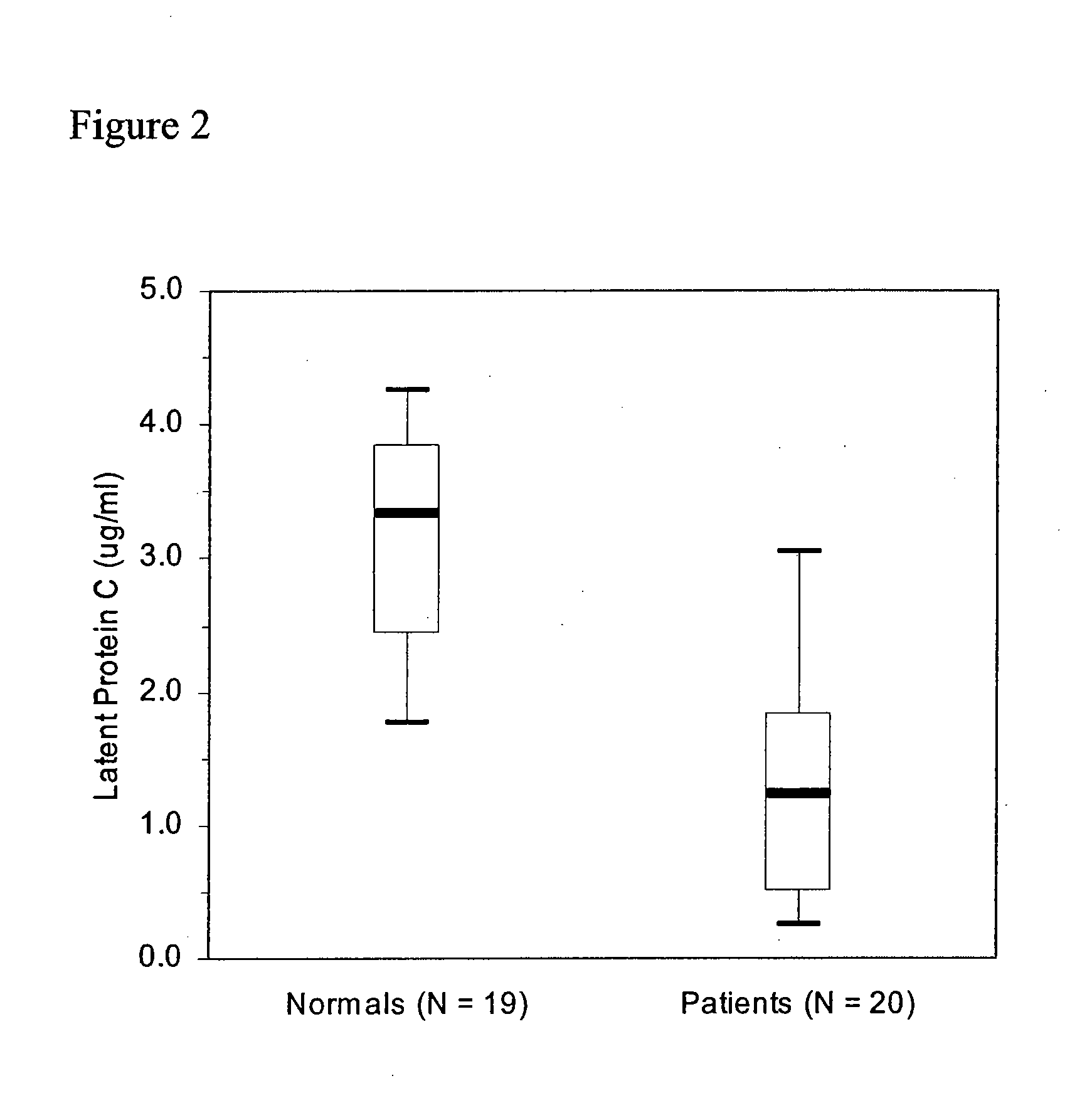Latent protein c assays and their uses for diagnosis and/or prognosis in systemic inflammatory response syndromes
a technology assays, applied in the field of latent protein c assays and their use for diagnosis and/or prognosis of systemic inflammatory response syndrome, can solve problems such as insufficient reflectiveness of assays
- Summary
- Abstract
- Description
- Claims
- Application Information
AI Technical Summary
Benefits of technology
Problems solved by technology
Method used
Image
Examples
example 1
Preparation of Antibodies Specific to Latent Protein C
[0130] Human latent protein C (Catalog # HPC 1001) and activated protein C (Catalog # APC) were purchased from Enzyme Research Labs (South Bend, Ind.). FVB mice (Taconic, Hudson, N.Y.) were immunized by subcutaneous administration of 50 μg of latent protein C mixed with 15 μg of Quil A adjuvant (Accurate Chemical and Scientific Corp, Westbury, N.Y.) in PBS, pH 7.4 on day 0. Two subsequent immunizations were performed on days 14 and 28 using the antigen mixed with Quil A. On day 36, blood samples were obtained from the mice by retro-orbital plexus bleeds and serum IgG responses were determined by ELISA using biotinylated latent protein C and activated protein C immobilized in separate wells via neutravidin (Reacti-Bind™ NeutrAvidin™-Coated Polystyrene Plates, Pierce, Rockford, Ill.). Two consecutive boosts of 50 μg of protein were administered via intraperitoneal injection on days 42 and 43. On day 45, the mice were sacrificed an...
example 2
Microtiter Plate-Based Biochemical Analyses
[0135] General methods for performing sandwich immunoassays in microtiter plates are as follows: a monoclonal antibody directed against a selected analyte is biotinylated using N-hydroxysuccinimide biotin (NHS-biotin) at a ratio of about 5 NHS-biotin moieties per antibody. The antibody-biotin conjugate is then added to wells of a standard avidin 384 well microtiter plate, and antibody conjugate not bound to the plate is removed. This forms the “anti-marker” in the microtiter plate. Another monoclonal antibody directed against the same analyte is conjugated to alkaline phosphatase, for example using succinimidyl 4-[N-maleimidomethyl]-cyclohexane-1-carboxylate (SMCC) and N-succinimidyl 3-[2-pyridyldithio]propionate (SPDP) (Pierce, Rockford, Ill.).
[0136] Biotinylated antibodies are pipetted into microtiter plate wells previously coated with avidin and incubated for 60 min. The solution containing unbound antibody is removed, and the wells wa...
example 3
Microfluidic Device-Based Biochemical Analyses
[0139] Immunoassays may also be performed using microfluidic devices essentially as described in Chapter 41, entitled “Near Patient Tests: Triage® Cardiac System,” in The Immunoassay Handbook, 2nd ed., David Wild, ed., Nature Publishing Group, 2001.
[0140] For sandwich immunoassays, a plasma sample is added to the microfluidic device that contains all the necessary assay reagents, including HAMA inhibitors, in dried form. The plasma passes through a filter to remove particulate matter. Plasma enters a “reaction chamber” by capillary action. This reaction chamber contains fluorescent latex particle-antibody conjugates (hereafter called FETL-antibody conjugates) appropriate to an analyte of interest, and may contain FETL-antibody conjugates to several selected analytes. The FETL-antibody conjugates dissolve into the plasma to form a reaction mixture, which is held in the reaction chamber for an incubation period (about a minute) to allow ...
PUM
| Property | Measurement | Unit |
|---|---|---|
| concentration | aaaaa | aaaaa |
| concentration | aaaaa | aaaaa |
| blood pressure | aaaaa | aaaaa |
Abstract
Description
Claims
Application Information
 Login to View More
Login to View More - R&D
- Intellectual Property
- Life Sciences
- Materials
- Tech Scout
- Unparalleled Data Quality
- Higher Quality Content
- 60% Fewer Hallucinations
Browse by: Latest US Patents, China's latest patents, Technical Efficacy Thesaurus, Application Domain, Technology Topic, Popular Technical Reports.
© 2025 PatSnap. All rights reserved.Legal|Privacy policy|Modern Slavery Act Transparency Statement|Sitemap|About US| Contact US: help@patsnap.com


